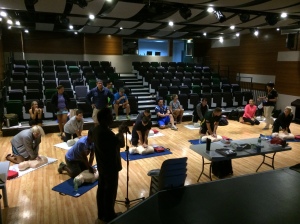You don’t need to be a nurse or a doctor to be able to administer CPR in an emergency situation. And medical professionals cannot overemphasize the fact that for every minute delay in administering cardiopulmonary resuscitation or CPR after the arrest, the person’s survival rate decreases by 10 to 15 percent.
As a rule of thumb, CPR must be performed within three to four minutes of the event or sooner. Prompt initiation of CPR by any bystander can double or even triple the chances of success of reviving the person from cardiac arrest without brain damage.
Randy Boss, a certified risk architect at Ottawa Kent in Jenison, Michigan published a story online via http://ehstoday.com/health/safety-professionals-are-you-prepared-risk-sudden-cardiac-arrest, about a co-worker who passed away two months after she suffered from an unexpected or sudden cardiac arrest while at work. Emergency workers succeeded in resuscitating her, but the delay was too much to prevent irreversible damage on the brain, causing her death.
For Randy Boss, it was one of the most devastating experiences he can remember which led him to learn as much as he could about Sudden Cardiac Arrest or SCA. Boss made a promise to make sure that the companies they work with “KNOW THE IMPORTANCE OF HAVING THE NECESSARY TOOLS” readily available if an emergency situation occurs at the workplace.
From data published online by the American Heart Association via “Heart Disease and Stroke Statistics – 2013 Update” on December 12, 2012, it showed that heart disease and stroke remain in the number 1 and number 4 ranking as causes of death, respectively.
Available statistics show that an estimated 300,000 to 400,000 deaths in the US every year are attributed to sudden cardiac arrest. In many cases, sudden cardiac arrest is fatal. Within 4 – 6 minutes of SCA, the person is at risk of irreparable damage if no CPR is administered. And lives can be saved by rapid treatment with a defibrillator.
CPR or cardiopulmonary resuscitation is administered to anyone whose heart stopped beating due to a heart attack or other causes of sudden cardiac arrest. It is important to learn how to perform CPR because it could spell the difference between life and death for the victim. Knowledge of CPR requires doing it effectively in order to save the life of a loved one or someone else.
In the case of Randy Boss’ co-worker, serious brain damage could have been prevented if someone from the workplace knew how to perform CPR or if the emergency workers arrived sooner, the result would have been different.
The critical period is the first three to four minutes after cardiac or pulmonary arrest. 3 to 4 minutes is all the time the victim has for increased chances of survival. Beyond that, every minute passing by diminishes the victim’s chances for survival and the brain sustains irreparable and irreversible damage from loss of or inadequate oxygen. Obviously important is the efficient and quick CPR in order to be successful in saving lives of cardiac arrest victims.
For medical practitioners and professionals, the American Heart Association’s BLS for Healthcare Providers or basic life support training provides the important knowledge, skills and techniques to perform CPR. For non-medical or those with no medical background, there is Heartsaver CPR AED course that provides the basic techniques and skills of performing efficient and effective CPR.
for Healthcare Providers or basic life support training provides the important knowledge, skills and techniques to perform CPR. For non-medical or those with no medical background, there is Heartsaver CPR AED course that provides the basic techniques and skills of performing efficient and effective CPR.
By taking any of these courses, you are making yourself a qualified first responder in emergency situations, with the confidence, ability and knowledge to perform life-saving skills!

Reblogged this on iClinic-RN® and commented:
Thank you
LikeLike